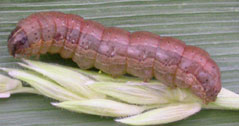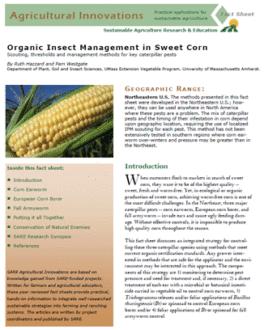
Fall Armyworm (Spodoptera frugiperda)
Like corn earworm, the fall armyworm is a summer migrant to the colder regions, over-wintering in Florida and other southern states. Fall armyworm moths, which are about ¾”to 1” long with clear hindwings and mottled brown forewings, migrate into New England and other northern areas in mid to late summer. The females lay scale-covered eggs on many types of plants, with a preference for whorl-stage corn. Eggs hatch in two to 10 days and larvae feed deep in the whorl as well as in tassels and ears. Like European corn borer they eat through the side of the corn ear; however, unlike European corn borer, fall armyworm leave behind a large, messy opening. Larvae are smooth, brown or dark green with lengthwise stripes, and the head capsule is dark with a distinctive light-colored marking in the form of an inverted Y. Full-grown larvae reach 1 ½ inches. (Photo G).
Monitoring and thresholds
Watch whorl-stage corn for signs of ragged feeding damage and scout for larvae in the whorl and the emerging tassel. Feeding damage from fall armyworm is more obviously destructive than that of European corn borer; however, if you find only feeding damage and no larvae, it is likely that the infestation is over and larvae have pupated. The scouting method and threshold for fall armyworm are the same as for European corn borer: if 15% of plants are infested with either larvae, controls are needed.
Control
Foliar sprays are the only effective means of control for fall armyworm at this time. Bt products that contain Bt aizawi or Bt kurstaki and have fall armyworm listed on the label may be used. Spinosad is also a good alternative. Spray to control fall armyworm during whorl stage if they are above threshold. For tassel stage, see thresholds and methods described for European corn borer, above.
